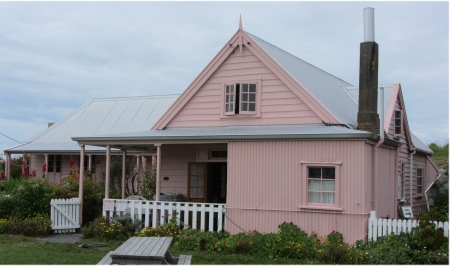
Fyffe House
|

Pou Tangaroa
|
The farmer boys with their big UTE and tents beside me kept their partying going on until around 6am. The silence did not last long, rain returned which I can usually ignore when sleeping in the car. However, I had to park under trees, and when the rain had worked its way through the canopy, there was an incessant crescendo of quiet and loud, single and rapid drips. For some reason my mind latches onto such sounds trying to analyse patterns, and it was pointless trying to sleep.
I arose, stepped out into the mud, cursed as I nearly slid onto my bum, and gingerly picked my way across to the washrooms. The farmer boys tents were surrounded by ducks sifting their way through crisp packets and discarded loaves of bread.
I ate my cereal sheltering under the rear door of the hatchback, and exchanged greetings with the Scottish guy I had met in the kitchen yesterday. He was taking his small dog for a walk. Fortunately the dog was out of sorts, otherwise he would have been yapping at me all the time. Two girls emerged from two of the tents, exchanged grunts with the occupants, and made their way back to town, carefully adjusting their clothing as they went. How that worked out with two guys per tent I'll never know, perhaps best if I don't.

A Collection of Whale Bones
|
I didn't want another night of drunken partying, so I packed up and moved on to a different campsite. When I checked in, I said to the woman on the desk, "I'd like space for one car please, preferably nowhere near a group of drunken idiots." She and the other customer laughed, "I'm afraid you'd get that sorry state of affairs everywhere last night. I'll put you in this section over here," she said pointing on a map, "There are only a couple of families staying on that patch." The patch seemed reasonable, but the families were nowhere to be seen.
I felt more comfortable with this campsite, and since the rain had abated, immediately set off to explore Kaikoura, a special place of lush pastures and towering, snow-capped Kaikoura Range peaks, a branch of the Southern Alps that come nearly to the sea at this point. The small town was well placed in the lee of the Kaikoura Peninsula.
Long, long ago a Maori explored the area, and stopped to eat the crayfish which so impressed him that he named the place Kaikoura which translates as "meal of crayfish" ("kai"- food/meal, "koura" - crayfish). A whaling station was established here in 1842, and farmers soon followed.
I drove up to the lookout on the peninsula to get my bearings and also gain a good overall view of the Seaward Kaikoura Ranges. Mount Manaku towered above the surrounding peaks, with snow still visible on its upper flanks. Mount Fyffe, named after the first family to settle in Kaikoura, sat at the base of the peninsula. It was all quite magical, real Lord of the Rings material.
For a culture shot, I headed down to Fyffe House, the town's oldest remaining house built in 1842 by Robert Fyffe. Rose pink in colour (a mixture of white and red lead, the only options available at the time), and resting on whale vertebrae foundations, Fyffe House is a rare survivor of New Zealand's early whaling industry. It began life as part of the Waiopuka whaling station in what is now Fyffe Cove, founded in 1842 by Robert Fyffe. Originally a two-roomed cooper's cottage, it was extended around 1860 to accommodate a growing family. The building contained relics of the whaling industry and detailed snapshots of the way generations had lived here since the 1840s. Today, it is girdled by a charming cottage garden and its grounds are used for a variety of community activities. Robert's cousin, George Fyffe, came out to join him, and when Robert was drowned while transporting whale oil to Wellington, George took over the business. However, it wasn't that long afterwards when George came to a nasty end, supposedly being of an unsound mind, and his wife died months afterwards.

